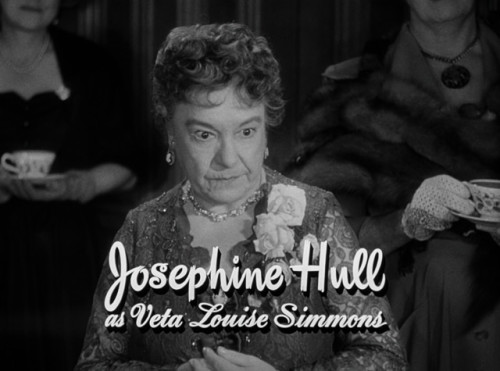This is a guest post by Brigit McCone.
“You’ve got a lot to learn, Myrtle Mae, and I hope you never learn it.” These words, from 1950’s Harvey, apply equally to sex and sanity. Harvey’s young women, Myrtle Mae and Nurse Kelly, are open and assertive about their sexual desires and frustrations. It is the older woman, Veta, who is inhibited. She flinches when a bosom jiggles and squirms when discussing sex. Society’s usual concept of sexual inhibition, as a natural innocence corrupted by experience, is flipped in Harvey: female sexuality is the natural innocence that experience disciplines into inhibition. Myrtle Mae and Nurse Kelly have a lot to learn, and we hope they never learn it.
As for sanity, Veta shares her brother’s ability to see Harvey, and hopes Myrtle Mae never learns the cost of socially unacceptable visions. Harvey‘s author, Mary Chase, won a Pulitzer for her dissection of the social stigma of insanity, but another aspect is less discussed: Harvey‘s insightful exploration of the gendering of madness. James Stewart’s Elwood P. Dowd accepts his rabbit visions without foreboding; Veta is haunted by the threat of losing social protection. Elwood is comfortable being stripped and bathed; for Veta, it is traumatic violation. Elwood’s accounts of Harvey receive sympathy from Doctors Sanderson and Chumley; Sanderson pathologizes Veta’s accounts as neurosis and cunning. In the midst of madness, we are in gender. Elwood P. Dowd has a lot to learn, and we hope he never learns it.
There is a contrast between the empowerment of psychotic males, in films like Fight Club and A Beautiful Mind, and the paternalist portrayal of psychotic females, in films like Benny & Joon and Barefoot. Insanity is open season for society’s most troubling ideas about controlling the female body. Bitch Flicks recently compared Black Swan and Birdman, highlighting their gendering of psychosis. The psychosis of Michael Keaton’s Riggan (Birdman) is existential, and ends with magic realist emancipation. The psychosis of Natalie Portman’s Nina (Black Swan) is psychosexual, and ends with masochistic self-destruction. If you want complex, autonomous psychotic heroines, you must look to life and not fiction: to Joan of Arc, Camille Claudel or Sylvia Plath.

Full disclosure: several years ago, I was institutionalized for a psychotic breakdown. Psychosis is a state of waking dream. Most mystical traditions contain techniques for inducing it: sensory deprivation, sleep deprivation and fasting; hyperstimulation such as frenzied dance; the ingestion of magic mushrooms, peyote or ayahuasca. When these drugs, or synthetic chemicals like LSD, are ingested for secular purposes, that recreational psychosis is called “tripping.” When psychosis is induced by the hyperstimulation of bipolar mania, or by schizophrenia, it’s called mental illness. Like other disinhibited states such as drunkenness, psychosis can lead to violence, but murderous rage is not a direct symptom. Using “psycho” for both psychotic and psychopathic conditions adds to the confusion – see this Bitch Flicks article, which presents evidence that Gone Girl‘s Amy is not psychotic to argue that she’s not psychopathic. Incidentally, the empathy deficiency that defines sociopaths (psychopaths) doesn’t necessarily cause sadism. Benedict Cumberbatch’s “high-functioning sociopath” Sherlock represents a real phenomenon: sociopathic emotional detachment suits high-risk, life-saving professions like surgery or criminal profiling. Who acknowledges the hardworking psychopaths that save lives daily? Homicidal maniacs are too dramatic; we’ve hardly seen a decent, pacifist maniac since Elwood P. Dowd.
The following Golden Gogol Awards are exclusively for cinematic representations of psychosis. So, no depressives from Girl, Interrupted or Prozac Nation, no sociopaths from Gone Girl. Films about insanity tend to be scrutinized for accuracy. Yet, what other issue does cinema represent accurately? Cinema does not represent. Cinema expresses, in the most visually dramatic way possible. Therefore, I’ll be awarding Golden Gogols, not according to technical accuracy, but according to the truth of a film’s overall message about mental illness. Actors like Josephine Hull, Isabelle Adjani, Russell Crowe and Natalie Portman have all scored Oscar nods for psychotic characters, but how will their films fare in the Golden Gogols?
First Principle: Audience Should Share the Psychotic Perspective

Nikolai Gogol’s Diary of a Madman is the original first-person narrative of psychotic breakdown. In the midst of hero Poprishchin’s confused ramblings, he reports finding a lapdog’s letters. The letters are clear, rational and fit the audience’s interpretation of the situation; readers can only be assured of their mental superiority by assuming that the madman is incapable of imagining these letters. The reader’s assumed mental superiority over madmen is thus made conditional on their believing that lapdogs can write (Gogol, how I love you).
One criticism of Ron Howard’s A Beautiful Mind was that it inaccurately portrayed Nash’s delusions. Nash heard voices, he didn’t see imaginary people. I don’t have a problem with this, though, because embodying Nash’s delusions serves a definite purpose: it allows the audience to share his perspective and his shock when the insanity is revealed. However, I think Fight Club is the film A Beautiful Mind wishes it was, seducing audiences into the hero’s paranoid empowerment fantasy without resorting to cheap sentiment.
So, how do narratives of female psychosis compare? Sylvia Plath’s novel, The Bell Jar, is an uncomfortably powerful, first-person portrait of psychotic breakdown. Bruno Nuytten’s film, Camille Claudel, by contrast, shows the inadequacy of realist cinema when portraying psychotic heroines. His film is beautiful, but fetishizes Isabelle Adjani’s fragility, presenting Claudel’s psychosis as pitiful spectacle and test of Rodin’s loyalty, rather than as psychological challenge for Camille herself. The approach of Julie Taymor’s Frida would have served better; Taymor’s visual blending of Frida’s art and life could have been used to center Claudel’s perspective, with its psychotic blending of imagination and reality. Black Swan wins the category as a great example of a film that shares the psychotic artist’s disorienting perspective.
Of course, one great psychotic heroine is Buffy Summers. In season six’s “Normal Again,” Buffy wakes on a psychiatric ward, where a psychiatrist explains all six seasons of Buffy the Vampire Slayer as manifestations of her psychotic empowerment fantasy. Meanwhile, in the Buffyverse, Buffy’s friends attempt to cure her of the hallucination of the psychiatric ward. The brilliance of this device is that the audience must confront their own desire for Buffy to reject reality, and return to the empowerment of the Buffyverse. We deeply want our heroine to be the Chosen One, not a pathetic, traumatized mental patient struggling with stigma. If you’ve ever wondered why a person with obvious mental problems was frustratingly resistant to interventions and cures, now you know: the same reason why we never acknowledge Buffy as psychotic heroine. This is why it is vital for the audience to share the psychotic perspective: Buffy’s resistance to recovery is incomprehensible from any perspective outside the Buffyverse, but totally sympathetic and rational to viewers who are emotionally invested in her female empowerment fantasy.
Second Principle: Protagonist Should Be Responsible For Recovery

You cannot cure dissociative identity disorder by shooting yourself in the face. Kids, don’t try this at home. But the hero’s painful wounding while destroying Tyler Durden, like Buffy’s painful attempt to destroy her Buffyverse friends, gives vividly cinematic expression to the annihilation of self that is demanded when submitting to treatment. I love Fight Club‘s portrait of mental illness because the film never questions that Tyler is the hero’s own problem to confront and resolve. Similarly, it allows Marla Singer to be openly damaged while being wickedly witty, insightful and capable of asserting romantic boundaries. Tell me that’s not refreshing.
Buffy’s decision to return to the Buffyverse is also shown to be her own responsibility. It is a challenging cop-out: challenging, because it forces us to admit that we don’t want her cured, but a cop-out, because accepting her disempowerment and confronting harsh reality would surely be the heroic path. Elwood’s conscious decision to choose Harvey and alcoholism is equally challenging; it asks that we judge sanity by quality of life rather than by social evaluations.
Camille Claudel died in an asylum, but she wrote letters there, that wrestled the mental pressure of being institutionalized. If the film Camille Claudel had ended with this protesting voice, rather than the image of Claudel being carted away as pitiful spectacle, that would have asserted autonomy as effectively as any happy ending. I haven’t yet seen Camille Claudel 1915, but it sounds like a useful companion-piece redressing that balance. Screen representations of psychosis have never bettered 1928’s The Passion of Joan of Arc, featuring legendary psychotic artist Antonin Artaud. Brilliantly contrasting the stigmatizing of psychotic religious revelation with the acceptability of religious groupthink, the film portrays Joan’s psychosis with uncomfortable clarity (Maria Falconetti is perfection), while still making you root for her autonomy. It is also sensitive to gender: Joan is judged monstrous by a court of leering men, while crowds of women weep at her martyrdom as though female power itself is burning.
Though addiction is commonly acknowledged as an illness, I’ve never heard it called mental illness. Yet, addiction is a pattern of thought that has become compulsive. Recovery requires the addict to accept their condition as dysfunctional, submit to treatment, attend support groups, identify emotional triggers and adjust daily routines. That is true of most other mental illness. The reason we don’t tell addicts they’re mentally ill is because “mental illness” is a dehumanizing stigma, not an empowering diagnosis. A Beautiful Mind wins this category because it applies addiction’s recovery narrative to psychosis, while Russell Crowe’s raw performance rings true. Harvey gets special mention for paralleling Elwood’s addiction and his psychosis. But from a psychotic perspective, Black Swan is like an addiction narrative ending with the protagonist drowning in their own vomit. Not impossible, but a stone-cold bummer.
Third Principle: Social Stigma Should Be Realistic

I’ve been criticizing Nuytten’s Camille Claudel, but it actually wins this category, along with The Passion of Joan of Arc, as the strongest examinations of society’s stigmatizing of female psychosis and its feminist connection to stigmatized female unruliness. Diary of a Madman is the brilliant male equivalent, challenging our instinctive mockery by the horror of the hero’s institutionalization. Psychosis is frequently flamboyant; it tests social tolerance. Our theoretical sympathy can’t withstand the actual outbursts of Amanda Bynes. For insight into this stigma’s impact on recovery, ask Sinéad O’Connor.
A Beautiful Mind, though, bends backwards to avoid challenging the audience’s comfort. Nash’s anti-Semitic outbursts are erased, making Super Crip easier to admire. Nash’s wife is easier to admire after erasing their 1963 divorce. The Nobel foundation is more admirable without their decision to prevent Nash’s acceptance speech. Nash’s colleagues admirably welcome him back. A Beautiful Mind is calculated, feel-good fellation of society’s savior complex. Gag.
By contrast, Harvey cunningly uses a non-threatening portrait of psychosis itself, to expose the irrational foundations of social stigma. Fight Club explores the attraction of Durden’s delusional conviction; society’s urge to fetishize Tyler as “Super Criptator” is a clear obstacle to his recovery. The mixture of visceral horror and pitying love on the faces of Buffy’s parents in “Normal Again” is equally spot-on. So far, Buffy ticks all boxes.
Final Principle: Heroine’s Psychosis Should Be Recognized

Here’s where Buffy fails: critics, fans and feminists alike are uncomfortable acknowledging Buffy’s psychosis. If not Buffy, then who is womankind’s witty, psychotic Tyler Durden (Golden Gogol: Best Psychotic Hero)? Is it really more inspiringly feminist to wrestle vampires than to wrestle psychological challenges? I’m with Veta (Golden Gogol: Best Supporting Psychotic). Feminists have a lot to learn, and I hope they never learn it.
[youtube_sc url=”https://www.youtube.com/watch?v=CxJSGMK9yRE”]
Winner: Golden Gogol for Best Psychotic Film
Brigit McCone writes and directs psychotic short films and radio dramas and is the author of “The Erotic Adventures of Vivica” (as Voluptua von Temptitillatrix). Fight Club is her favorite psychotic romcom.








